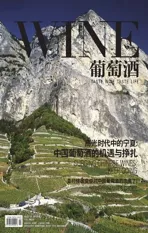不被看好的葡萄品种
2019-11-02TersinaShieh张恬熙
文|Tersina Shieh 编、译|张恬熙

勃艮第葡萄酒协会(简称:BIVB)会定期在城中举办大师班,但他们大部分时候都在主推霞多丽和黑皮诺这两个有名的葡萄品种。正因如此,当得知今年首个BIVB大师班以“深度解析阿里高特葡萄”为主题时,才会让人如此惊喜。说实话,这真的太棒了!
Bourgogne Wine Board (BIVB) organises regular masterclasses in town but most of them are focused on their famed grape varieties Chardonnay and Pinot Noir.Therefore, the fact that the first BIVB masterclass this year was‘An in-depth analysis of the Aligoté grape’came as a surprise-in fact, a very nice surprise.
我敢肯定,并不是所有的勃艮第爱好者都听说过阿里高特。自17世纪以来,这个葡萄品种就在勃艮第安家落户,但直到1937年它才获得了属于自己的AOC—勃艮第阿里高特AOC。1997年,布泽宏(译者按:唯一允许使用阿里高特酿酒的村庄级法定产区,且产区内也只允许种植该葡萄品种)成为村庄级法定产区。尽管勃艮第的种植面积很大,自北部的夏布利延伸至南部的马贡产区,但阿里高特的种植面积仅占6%。这个葡萄品种曾经和霞多丽有同样的地位,但令人遗憾的是,在经历根瘤蚜虫灾害后,果农们放弃了阿里高特,选择了(在短期内)更容易酿出好品质葡萄酒的霞多丽。
用阿里高特酿出的葡萄酒很微妙,有活泼的酸度和矿物气息,这种葡萄酒能升华食物的美味而非蛮横地争当“主角”。它的酒体结构和细腻感让我联想到猎人谷的赛美蓉。许多人一开始或许会因为它们不像霞多丽或长相思那么“妩媚”而将其拒之门外,但如果你愿意花时间去等待的话,就一定会得到回报。艾薇(Ivy)就很乐意与人们分享一款18岁高龄的阿里高特葡萄酒,这款酒带有层层的异国香料的气息,可口而轻盈。
如今有不少葡萄品种名声欠佳,尤其是中性葡萄,这并不是因为它们不像其同品系兄弟姐妹那般夺目,而是由于葡萄农和酿酒师把它们视作“老黄牛”,将产量最大化,用来蒸馏或酿造毫无特色的葡萄酒。如果给予它们得当的葡萄园管理,这些葡萄品种的质感与配餐的灵活度则可以弥补它们缺乏诱人香气的缺点。以阿里高特为例,它主要用于酿造基尔酒和勃艮第起泡酒,并在今年的大师班上脱颖而出。这些葡萄酒是由少数用心、严肃对待这种葡萄的酿酒师酿造而成。
在众多的酿酒葡萄中仍有不少弱势群体,特别是爱伦、白皮诺和米勒-土高。爱伦是西班牙种植最广泛的葡萄,主要用于蒸馏或酿造平庸的葡萄酒,但我喝过一些表现不错、挑战这条准则的酒款,比如来自拉曼恰产区马斯特维诺酒庄(Más Que Vinos)的爱伦葡萄酒。白皮诺基本上是一种百搭的餐酒,德国正以威斯堡格德(德国的白皮诺)的名义领导其复兴之路。复兴者之中就包括巴登产区的施蒂格勒酒庄(Weingut Stigler),酒庄酿造的依瑞恩温克乐堡特级葡萄园白皮诺干白葡萄酒来自其最古老的地块,这款葡萄酒适合各式各样的粤菜,从虾饺到烤乳猪都可以完美搭配。
至于米勒-土高(在德国叫做黎凡纳),它主要生长在凉爽的产区,比如德国、英国和意大利北部。这个葡萄品种在1882年由雷司令和古德尔杂交而成,目的是为了培育出比雷司令更早熟,产量更大的葡萄。如你所料,酿出来的葡萄酒通常口感寡淡。但我相信,这只丑小鸭总有一天会实现华丽的变身。我酿造的第一款酒就是米勒-土高,使用了4种不同的酵母进行发酵,这也是我在普兰顿酒庄的最后一个项目。现在,我仍然保留着其中的2瓶酒,等时机成熟时就会开瓶享用。

I’m pretty sure that not all Burgundy fans heard of Aligoté.The grape has been grown in the region since 17th century and was granted its own AOC, Bourgogne Aligoté, in 1937.In 1997, Bouzeron was recognised as its village appellation.Despite its large growing area in Burgundy from Chablis in the north to Mâconnais in the south, it only has 6% of the planting.It used to have equal footing with Chardonnay but sadly after phylloxera,vinegrowers ditched Aligoté for the more accessible Chardonnay.
Aligoté is subtle with lively acidity and a mineral note, a wine in the background that supports food rather than taking the centre stage.Its texture and subtlety reminded me of Semillon from Hunter Valley.Most people may dismiss them at first sip because they are not as pretty as Chardonnay or Sauvignon Blanc, but you will be rewarded especially if you have the patience to wait.Ivy was very kind to share an18 years old Aligoté which has layers of exotic spices and a savoury yet light palate.A lot of grapes, especially those neutral ones, suffer from poor reputation not because they don’t shine like their more glamorous siblings but because vinegrowers and winemakers treat them like work horse grapes, maximising their yield for distillation or making characterless wine.However, given proper management in the vineyards, the lack the attractive aromas of these varieties is often more than compensated by its texture and flexibility to match with food.Take Aligoté for example, mainly used for Kir and Cremant de Bourgogne, spoke out in this masterclass.The wines presented were made by the few dedicated winemakers who take the variety seriously.
There are still many underdogs in the wine world, notably Airén, Pinot Bianco (or Pinot Blanc) and Müller Thurgau.Airén is the most widely planted grapes in Spain mainly destined for distillation or mediocre wine, but I did try a couple including Más Que Vinos in La Mancha that defy the norm.Pinot Bianco is pretty much an inoffensive house wine but Germany is leading the way to revive it under the name of Wiessburgunder (Pinot Blanc in German).Weingut Stigler in Baden, amongst others, produces a Weissburgunder Trocken, Ihringen Winklerberg "GG'' from its oldest Weissburgunder plot.The wine was wonderful with a wide spectrum of Cantonese dishes from shrimp dumpling to roasted suckling pig.As for Müller Thurgau (also known as Rivaner in Germany) mainly grown in cooler regions such as Germany, England and Northern Italy, is a cross between Riesling and Gutedel created in 1882 to produce earlier ripening and bigger crop than Riesling.As you can imagine, the wine is often light and unassuming.But I have faith that this ugly duckling will one day be transformed.The first wine I made was Müller Thurgau fermented in four different yeasts for my final project at Plumpton.I still have two bottles with me and am waiting for a suitable occasion to open them.
